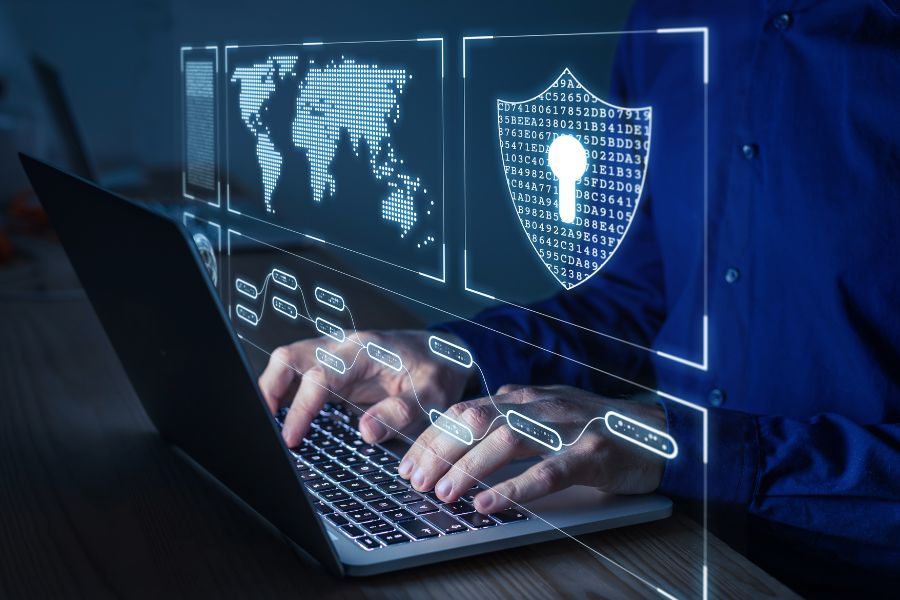Navigating the Intersect of Blockchain, Cybersecurity, and Covert Networks
January 31, 2024, 5 min read
As we embark on a journey through the digital landscape of the 21st century, the evolution of the cyber realm emerges as a captivating narrative intricately woven with the threads of technological innovation and human ingenuity. Blockchain technology is at the forefront of this evolution – a paradigm-shifting breakthrough that redefines security, trust, and transparency in the digital world.
Blockchain, often hailed as the backbone of the new internet era, has transcended its initial role in cryptocurrency to become a foundational element in various sectors. Its immutable ledger and decentralized nature have disrupted traditional financial systems and paved the way for revolutionary applications in data security, supply chain management, and beyond.
Yet, as we navigate this new digital frontier, the rise of blockchain also ushers in complex challenges and uncharted territories in cybersecurity. The very features that make blockchain a bastion of security also attract sophisticated cyber threats, creating a paradox that demands a nuanced understanding and proactive approach.
This narrative is not just about technology; it’s a tale of the relentless pursuit of innovation, the constant battle against cyber threats, and the quest to safeguard our digital future. As we focus deeper on blockchain and cybersecurity, let’s unravel the complexities and explore how this technology reshapes the cyber world.
Cryptographic Fortresses: The Paradox of Blockchain in Cybersecurity
As we look closer at the complex interplay of blockchain and cybersecurity, it becomes clear that this innovative technology is not just a tool but a transformative force in the digital age. Blockchain, renowned for its robust security protocols, has redefined the landscape of digital transactions and information exchange. Its decentralized nature and cryptographic fortification offer unprecedented security, making it a formidable barrier against conventional cyber threats.
However, this very strength of blockchain also introduces new challenges. Cybersecurity in the blockchain era is not a static battlefield but a dynamic arena of evolving threats and defenses. As hackers adapt to the complexities of blockchain, their methods become more sophisticated, leading to a cat-and-mouse game between security experts and cybercriminals. This emerging scenario necessitates an advanced approach to cybersecurity that is as agile and innovative as the technology it seeks to protect.
In this intricate dance of digital defense, the role of blockchain extends beyond a secure platform; it becomes a catalyst for rethinking and reshaping our approach to cybersecurity. By understanding and leveraging the unique features of blockchain, we can not only defend against current threats but also anticipate and prepare for future challenges in the ever-evolving cyber landscape.
Economy in the Shadows: The Interplay of Dark Web and Cryptocurrencies
Venturing deeper into the digital landscape, we encounter the shadowy realms of the Dark Web and its complex relationship with cryptocurrencies. This hidden part of the internet, inaccessible through standard browsers, harbors legitimate privacy-focused activities and illicit transactions. The emergence of cryptocurrencies, especially those prioritizing anonymity like Monero and Zcash, has become a double-edged sword in this clandestine space.
Cryptocurrencies, with their decentralized nature and robust encryption, provide a haven for privacy-conscious individuals. However, these features also attract cybercriminals, who exploit them for untraceable financial activities. This paradox presents a unique challenge: ensuring the legitimate use of cryptocurrencies for privacy and freedom while combating their use in cybercrime.
The intertwining of cryptocurrencies and the Dark Web reflects a broader theme in the digital age: the constant balancing act between privacy, freedom, and security. As we explore this interplay, we gain insights into the complexities of the digital economy and the ongoing efforts to maintain a secure yet open digital world.
Hackers and Privacy Tokens: The Emergence of Privacy-Centric Cryptocurrencies
Building on the complexities of the Dark Web and cryptocurrencies, we now focus on hackers and the burgeoning world of privacy tokens. This arena, where cutting-edge technology meets underground tactics, is a testament to the constantly evolving nature of cybersecurity.
Hackers, once viewed solely as cyber outlaws, now embody a spectrum of personas, from rogue actors to ethical guardians of the digital realm. Their intricate dance with privacy tokens – digital currencies designed to preserve user anonymity – represents a new frontier in the cyber world. These tokens, such as Monero and Zcash, are not just currencies but tools of empowerment, offering a privacy shield in an increasingly surveilled digital landscape.
However, this empowerment also poses significant challenges. The anonymity privacy tokens provide can be a double-edged sword, serving both the privacy-conscious public and cybercriminals’ clandestine activities. This duality is a crucial aspect of the modern digital ecosystem, reflecting the ongoing tension between privacy, security, and ethical use of technology. As we explore this dynamic space, we gain a deeper understanding of the multifaceted role of privacy tokens in shaping the cybersecurity landscape.
Monero and Anonymity: The New Currency of Cybercriminals
As we progress from the intricate dynamics of hackers and privacy tokens, we arrive at the heart of Monero and the concept of anonymity in the digital currency world. Monero, a leading privacy-focused cryptocurrency, stands as a beacon of anonymity, allowing users to conduct transactions with a level of privacy unattainable in traditional financial systems.
This emphasis on anonymity is not merely a feature; it reflects a growing demand for privacy in an increasingly transparent digital age. However, the veil of anonymity also presents significant challenges, particularly in law enforcement and financial regulation. Cybercriminals’ use of Monero and similar cryptocurrencies highlights the fine line between protecting individual privacy and preventing illicit activities.
In this segment of our exploration, we delve into the implications of such privacy-centric cryptocurrencies, examining how they reshape the landscape of digital transactions and the ongoing efforts to balance privacy rights with security concerns.
Cybersecurity in the Blockchain Era: Challenges and New Strategies
In the sixth segment of our exploration, we confront the formidable challenges and new strategies in cybersecurity within the blockchain era. The rise of cryptocurrencies like Monero, which prioritize user anonymity, has compelled cybersecurity experts to rethink traditional security paradigms. This new era demands more than just robust firewalls and antivirus programs; it calls for a holistic approach encompassing advanced cryptographic techniques, vigilant network monitoring, and innovative thinking.
The task is to defend against existing threats and anticipate and adapt to cyber adversaries’ ever-evolving tactics. This proactive stance in cybersecurity is crucial in maintaining the delicate balance between the freedom and privacy afforded by blockchain technology and the imperative of safeguarding the digital ecosystem against malicious activities. This part of our journey highlights cybersecurity’s dynamic and adaptive nature in an age where digital innovation continuously redefines the rules of engagement.
Conclusion and Future Outlook: The Impact of Blockchain on Security Dynamics
As we approach the conclusion of our exploration, it’s crucial to reflect on blockchain’s future outlook and its impact on security dynamics. This journey through cybersecurity, blockchain, and digital anonymity has revealed a landscape in constant flux, driven by technological advancements and ever-shifting cyber threats.
Looking ahead, integrating blockchain into various sectors presents both opportunities and challenges. It promises enhanced security, transparency, and efficiency but also necessitates ongoing vigilance against new cyber threats. The future of cybersecurity in the blockchain era will likely be characterized by continuous innovation, cross-disciplinary collaboration, and a proactive approach to safeguarding digital assets.
As we embrace these changes, the narrative of blockchain and cybersecurity is not just about technological evolution but also about the global community’s resilience and adaptability in the face of digital transformation. This ongoing story underscores the need for a balanced approach that harmonizes blockchain’s benefits with robust cybersecurity measures to foster a secure, transparent, and equitable digital future.
























